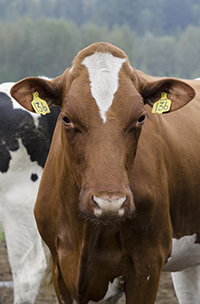 When light hits the eye, a cascade of hormonal events is triggered in the brain's pineal gland. This cascade begins with a signal to suppress the release of the hormone melatonin. As darkness falls, the inhibitory impact of light is dampened, and melatonin secretion rises.
When light hits the eye, a cascade of hormonal events is triggered in the brain's pineal gland. This cascade begins with a signal to suppress the release of the hormone melatonin. As darkness falls, the inhibitory impact of light is dampened, and melatonin secretion rises. Animals use the daily fluxes in the duration of elevated melatonin concentrations to set their internal clock, which influences the secretion of a number of hormones.
"Consequently, days with greater light exposure are associated with a shorter duration of high concentrations of melatonin," noted Geoff Dahl, University of Florida, when speaking at the Penn State Dairy Cattle Nutrition Workshop.
Prolactin's circulating levels are affected by melatonin and photoperiod. Prolactin is a hormone that enables female mammals to produce milk, and it plays a significant role in muting or enhancing cows' milk production in the subsequent lactation.
Unlike their lactating counterparts, dry cows respond poorly when they're managed under long-day lighting (16 hours of light and 8 hours of dark). Research conducted by Dahl showed that cows exposed to long-day lighting during the dry period make less milk in the next lactation.
With short-day lighting, cows are exposed to 8 hours of light and 16 hours of darkness over the entire dry period. The dry cow's milk production bump occurs when light exposure and prolactin concentrations are diminished.
"Elevated prolactin concentrations during the dry period aren't our friend," added Dahl. In his work, short-day lighting during the dry period reduced prolactin levels and was inversely related to greater prolactin receptor expression in lymphocytes and mammary tissue.
Cows on short days also had a higher dry matter intake during the dry period, but this difference did not persist after calving.
"The barn used to house dry cows can be open to light 8 hours per day – but it must be dark the rest of the time. This also necessitates the need for sufficient dry cow cooling in these barns," added Dahl.
When evaluating lighting options, Dahl recommends producers base their decision on the light's efficiency and the mount height that is most appropriate to the barn. "When installing lights, you want to achieve uniform light dispersion – invest in a light meter to help you evaluate that. The light meter should read approximately 15 foot candles one meter off of the stall floor.
To estimate the fixture requirements for your barn and evaluate the economic returns of manipulating photoperiods on your dairy, visit the link above.

The author is an associate editor and an animal science graduate of Cornell University. Smith covers feeding, milk quality and heads up the World Dairy Expo Supplement. She grew up on a Medina, N.Y., dairy, and interned at a 1,700-cow western New York dairy, a large New York calf and heifer farm, and studied in New Zealand for one semester.








